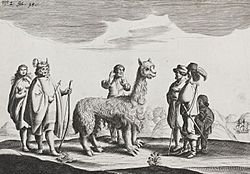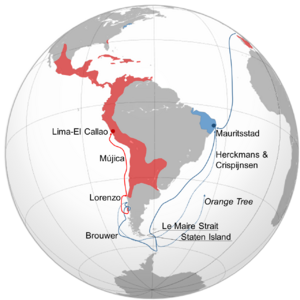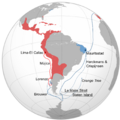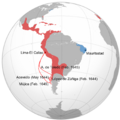Dutch expedition to Valdivia facts for kids
The Dutch expedition to Valdivia was a journey by sea led by the Dutch Republic in 1643. Their goal was to set up a new trading post and military base on the southern coast of Chile. At this time, the Dutch were at war with Spain (this was part of the Eighty Years' War). They hoped to take control of the old Spanish city of Valdivia, which had been left in ruins.
The expedition, led by Hendrik Brouwer, first attacked Spanish towns like Carelmapu and Castro in the Chiloé Archipelago. They had some help from the local native people. The Dutch reached Valdivia on August 24, 1643. They named their new settlement Brouwershaven to honor Brouwer, who had passed away a few weeks earlier.
However, this new colony didn't last long. The Dutch left Valdivia on October 28, 1643. Even though it was short-lived, the Dutch presence really worried the Spanish leaders. Because of this, Spain decided to rebuild Valdivia and started building a huge system of forts there in 1645. This was to make sure no one else could invade again. The Dutch expedition to Valdivia was the last time the Dutch tried to set up a colony on the west coast of the Americas.
Quick facts for kids Dutch expedition to Valdivia |
|||||||
|---|---|---|---|---|---|---|---|
| Part of the Eighty Years' War | |||||||
 Detail from the 1646 book Journael Ende Historis Verhael van de Reyse gedaen by Oosten de Straet le Maire, naer de Custen van Chili, onder het beleyt van den heer Generael Hendrick Brouwer, Inden Jare 1643 |
|||||||
|
|||||||
| Belligerents | |||||||
| Commanders and leaders | |||||||
Chiloé forces:
|
|||||||
| Strength | |||||||
| Several ships 600 men |
|||||||
Contents
Why the Dutch Went to Valdivia
The city of Valdivia was once a Spanish settlement. But in 1598, native Mapuche warriors attacked and destroyed many Spanish cities in southern Chile. This event is known as the "Destruction of the Seven Cities". Valdivia was one of the cities that was either destroyed or abandoned.
After this, most of Chile south of the Bío Bío River became free from Spanish rule. The abandoned city of Valdivia became a very attractive place for Spain's enemies to control. It had a great natural harbor and could be a perfect base in the middle of Spanish lands.
The Dutch had tried to attack Spanish areas in the Americas before. They were always looking for ways to weaken Spain. In the early 1640s, Spain was fighting many wars in Europe. This made the Dutch think it was a good time to try and set up a base on the west coast of America again. They hoped to cause trouble for the Spanish in their rich Viceroyalty of Peru.
The Expedition Begins
In 1642, two important Dutch trading companies, the Dutch East India Company and the Dutch West India Company, decided to organize an expedition. They chose Hendrik Brouwer, an experienced sailor, to lead it. Even though he was old, Brouwer was very keen on the idea of taking Valdivia.
The expedition was not very large, especially compared to the Dutch forces that had taken over parts of Brazil. However, the Dutch hoped that the native Mapuche and Huilliche people, who were fierce enemies of Spain, would help them once they reached Chile.
The main goals of the expedition were:
- To find and take control of gold mines in the area.
- To capture Valdivia.
- To make alliances with the local Mapuche and Huilliche people.
- To explore Santa María Island.
Most of the sailors and soldiers on the expedition didn't know the true goals. They thought it was just a trip for raiding and trading.
Brouwer's fleet left the Netherlands on November 6, 1642, with 250 men. They stopped in Dutch Brazil, where John Maurice of Nassau gave them more supplies and an extra 350 men. This meant the expedition had about 600 men in total.
While sailing around Cape Horn, the ships faced strong winds and icebergs. One supply ship, the Orange Tree, got separated and had to return to Brazil. This meant the expedition had fewer supplies than planned.
Arrival in Chiloé
In May 1643, the Dutch fleet reached the Chiloé Archipelago. The Spanish at the small fort of Carelmapu saw the Dutch ships. Spanish soldiers tried to stop them from landing, but the Dutch landed further away.
The Dutch soldiers marched towards Carelmapu, setting small fires to clear their path. The Spanish soldiers left the fort and hid their families in the forests. When the Dutch opened fire, the Spanish quickly retreated. The Dutch entered the fort, taking supplies and horses. A Spanish counter-attack failed, and the Spanish Governor of Chiloé, Andrés Herrera, was killed.
The Dutch then looted Carelmapu and damaged its church. This helped them get much-needed food. However, they also found a letter from the Spanish viceroy in Peru, Pedro de Toledo. The letter warned about a Dutch expedition and told the Spanish to destroy their own supplies to prevent the Dutch from getting them. The Dutch also captured some Spaniards, including Antonio Sánchez Jinés, who spoke the native Mapudungun and later guided them.
Fernando de Alvarado took over as the Spanish military commander in Chiloé. He quickly moved to Castro, another Spanish town, before the Dutch arrived. He ordered the people of Castro to hide in the forests. Buildings had their roofs removed so they couldn't be used for shelter or easily burned. When the Dutch arrived, they looted Castro and damaged its church, just like in Carelmapu.
After Castro, the Dutch sailed north, taking chickens, sheep, pigs, and apples from the countryside. Since most people were hiding, they didn't meet many locals.
In July, the expedition returned to Carelmapu. There, 470 Huilliche people agreed to join the Dutch on their journey to Valdivia. The Dutch spent the southern hemisphere winter (May to mid-August) resting and repairing their ships.
On August 7, Brouwer died in Puerto Inglés. As planned, Elias Herckmans took over command of the expedition.
Spanish Alert Peru
Meanwhile, the Spanish in Chiloé quickly built a small ship. This ship sailed to Arauco to warn the Spanish on the mainland. It was a dangerous journey in the winter storms. Once the Spanish leaders in Chile learned about the Dutch, they sent a captain, Alonso de Mujica y Buitrón, to Lima to tell the Viceroy of Peru.
The Dutch in Valdivia
The expedition sailed for Valdivia on August 21 and arrived three days later. Herckmans reached the mouth of the Valdivia River on August 24. It was hard for the Dutch to sail up the river to the old city site because they weren't used to river navigation. One ship got stuck and had to be taken apart. The two remaining ships reached the ruins of Valdivia on August 28.
When they arrived, curious Mapuche people gathered to watch them. The ships were surrounded by canoes, and some natives reportedly boarded the ships and took iron objects, including a valuable compass.
In Valdivia, the Dutch started building a new settlement. Herckmans named it Brouwershaven, after the late Brouwer. On August 29, the Dutch met with a local tribal leader named Manquipillan. The Dutch spoke about their shared dislike for Spain and gave gifts. A friendly relationship was formed. A few days later, on September 3, a larger meeting took place, and a formal alliance was made between the Dutch and the local Mapuches. The Mapuches promised to help the Dutch build a fort and provide food for the new colony. Brouwer's embalmed body was buried in Valdivia on September 16.
A ship was sent back to Dutch Brazil on September 25 to report the good news and ask for more supplies. In Valdivia, the Dutch began building a fort. However, a big problem for the Dutch was that they couldn't find the gold mines they expected.
The Mapuches started to realize the Dutch didn't plan to leave. The Dutch search for gold made the Mapuches suspicious, and they stopped bringing food. A Mapuche chief named Juan Manqueante refused to let the Dutch access the gold mines in his lands. He told the Dutch about his people's bad experiences with Spanish gold mining. The Mapuches of Valdivia had been living in peace for about forty years, and they might not have seen much difference between the Dutch and the Spanish. They also claimed they didn't have enough food for themselves.
The Dutch became discouraged by the lack of food and comfort. Some Dutch soldiers started to desert, leaving the camp at night to try and surrender to the Spanish in Concepción.
The Spanish interpreter, Antonio Sánchez Jinés, warned the Dutch that the Mapuches' attitudes were changing. He even feared for his life, saying the Mapuches wanted to kill him for telling the Dutch about gold and guiding them.
The local Mapuches even tried to trick some of the Dutch into leaving to fight an imaginary Spanish troop gathering. Herckmans called a meeting of Dutch officers on October 15. They decided to move to Constantino Island and abandon Valdivia. The next day, four deserters were arrested, and two were executed. More deserters were punished on October 26.
Before leaving Valdivia, the Dutch met with the local Mapuches. Herckmans let them know that he knew about their changing attitudes. Still, the Dutch gave away some old weapons and armor, like chain mail and helmets, in exchange for food. They probably hoped these weapons would be used against the Spanish.
Juan Manqueante provided some cattle to the hungry Dutch. This was only a temporary help, likely a farewell gift. Before leaving, Herckmans told Manqueante that the Dutch planned to return with 1,000 African slaves to work in mining and farming, so the native people wouldn't have to do forced labor. This promise was never kept.
Return to Brazil
The expedition finally left Chile on October 28 and arrived back in Recife, Brazil, on December 28. In Brazil, the extra supplies and reinforcements that had been requested were ready to sail for Valdivia. John Maurice of Nassau was disappointed to learn that the colony had been abandoned. The failure of the expedition was blamed on Herckmans, who died soon after.
In 1645, a major rebellion broke out in Dutch Brazil, causing the Dutch to lose most of their territory there. With no resources left, the Dutch gave up their plans for Chile.
Images for kids
-
Map showing the Spanish advances towards Valdivia in 1644 and 1645 as responses to the Dutch expedition to Valdivia. The various expeditions are shown in with red lines. Dutch possessions are show in blue and Spanish in red. Errata: López de Zúñiga's expedition occurred in February 1645 and not 1644.
See also
 In Spanish: Expedición neerlandesa a Valdivia para niños
In Spanish: Expedición neerlandesa a Valdivia para niños





